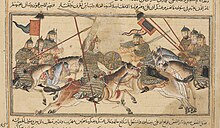| House of Nasher | |
|---|---|
| Parent house | Kharoti |
| Country | Afghanistan |
| Founded | 977 / 1709 |
| Titles | |
The Nasher (or Nashir) (Dari: الناشر, Persian: الناشر) are a noble Afghan family and Khans of the Pashtun Kharoti (Ghilji) tribe. The family is originally from Qarabagh, Ghazni but founded modern day Kunduz in the early 20th century and lived there until the end of the Barakzai dynasty in the late 20th century.
Origins and history

Nasher are referred to in 1120 A.H (1709 A.D.), when Ghilji Pashtun tribesmen under Khan Nasher successfully overthrew Safavid rule to establish the Ghilji Hotaki dynasty, which controlled Afghanistan from 1719 to 1729 A.D. and much of Persia from 1722-1729 until Nadir Shah of Persia seized power in the Battle of Damghan.
The Nasher lived as Khans of the Kharoti (Pashto: خروټی), a Pashtun tribe of Ghilji origin with an estimated population of about 5.5 million, making it one of the largest, if not the largest tribe in Afghanistan, with significant territory throughout eastern and south-eastern Afghanistan: Ghazni, Zabul, Paktia, Khost, Logar, Wardak, Kabul and Nangarhar.
In the 19th century

After the great Ghilji rebellion in 1885–1886, led by Alam Khan Nasher, the Nasher family was exiled by the ruling Barakzai King Amir Abdur Rahman Khan in order to weaken his nemesis. Sher Khan Nasher, Khan of the Kharoti soon became governor of the Kunduz district launched an industrialisation campaign, founding the Spinzar Company, with major urban development and construction programmes. Economic development transformed Kunduz into a thriving city with new residential housing, schools, and hospitals for the factory workers. Sher Khan Nasher also implemented Qizel Qala harbour that was later named Sher Khan Bandar in his honour. As his power grew and he eventually controlled the whole north of Afghanistan, the throne was within his reach, which is why there are theories that he was poisoned by the Barakzai king.
In modern history
Sher Khan's nephew and stepson Ghulam Sarwar Nashir developed Spinzar further, employing over 20,000 people and maintaining construction companies, a porcelain factory and hotels in Kunduz and throughout Afghanistan. Long before he became a radical, Nashir sent fellow Kharoti Hekmatyar to Kabul's Mahtab Qala military academy in 1968, as he considered him to be a promising young man. After he was expelled from the Mahtab Qala, Nasher imprisoned him briefly for toying with Communist ideology,
Der Spiegel reported in 2011 that the chief of the Kunduz district was Nizamuddin Nasher, considered to be the "last scion of a legendary Afghan dynasty" still living in Kunduz.
Notable people
- Sher Khan Nashir, founder of Spinzar Cotton Company and founding father of Kunduz
- Gholam Serwar Nashir (1922–1984), president of Spinzar Cotton Company
- Gholam Nabi Nasher (1926–2010), parliamentarian
- Gholam Rabani Nasher (1940–), member of the Loya Jirga
- Farhad Darya Nashir (1962–), singer and composer
Cities and places named after the Nasher
- Sher Khan Bandar, largest port of Afghanistan
- Nashir Museum, Kunduz
References
- "Shir khan port - Ministry of Commerce and Industries". Archived from the original on 2014-08-21. Retrieved 2014-09-16.
- Runion, Meredith L.: The History of Afghanistan, p. 63, at Google Books
- Personalities: An Examination of the Tribes and the Significant People of a Traditional Pashtun Province - Timothy S. Timmons and Rashid Hassanpoor (2007)
- The Wars of Afghanistan: Messianic Terrorism, Tribal Conflicts, and the Failures of Great Powers, p. 42, at Google Books Peter Tomsen, PublicAffairs, 2011
- Wörmer, Nils (2012). "The Networks of Kunduz: A History of Conflict and Their Actors, from 1992 to 2001" (PDF). Stiftung Wissenschaft und Politik. Afghanistan Analysts Network. p. 8
- Grötzbach, Erwin: Afghanistan, eine geographische Landeskunde, Darmstadt 1990, p. 263
- Emadi, Hafizullah: Dynamics of Political Development in Afghanistan. The British, Russian, and American Invasions, p. 60, at Google Books
- Tanwir, Halim: AFGHANISTAN: History, Diplomacy and Journalism Volume 1, p. 253, at Google Books
- del Castill, Graciana: Guilty Party: The International Community in Afghanistan, p. 58, at Google Books
- ^ Reuter, Christoph: Power Plays in Afghanistan: Laying the Groundwork for Civil War, 49/2011 (Dec. 5, 2011) of DER SPIEGEL http://www.spiegel.de/international/world/power-plays-in-afghanistan-laying-the-groundwork-for-civil-war-a-801820-2.html
- Roy, O.; Sfeir, A.; King, J (eds.): The Columbia World Dictionary of Islamism, p. 130, at Google Books
- Killing the Cranes: A Reporter's Journey through Three Decades of War in ...von Edward Girardet, p. 183, at Google Books
Further reading
- Dupree, Louis: Afghanistan
- Emadi, Hafizullah: Dynamics of Political Development in Afghanistan. The British, Russian, and American Invasions
| Pashtun tribes | |||||||
|---|---|---|---|---|---|---|---|
| Bettani |
| ||||||
| Gharghashti | |||||||
| Sarbani |
| ||||||
| Karlani | |||||||
| Allied tribes | |||||||
| Terminology | |||||||
